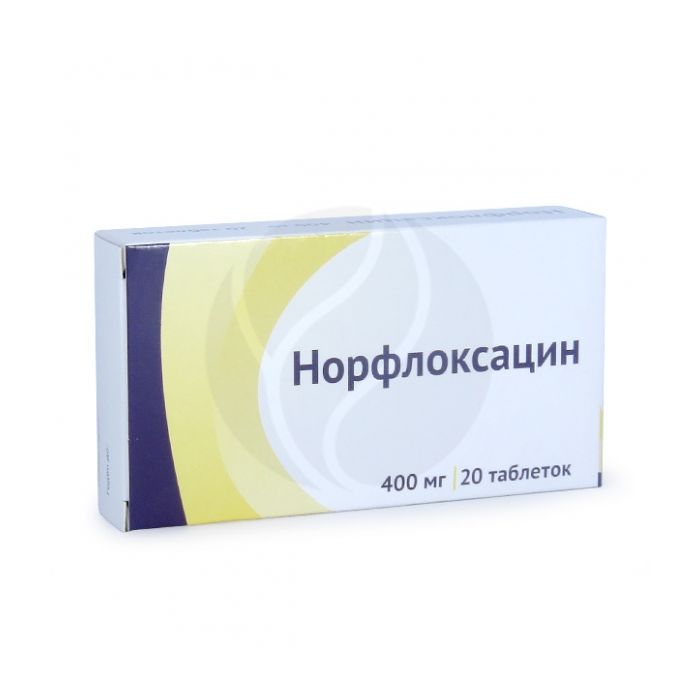Norfloxacin tablets 400mg, # 20
Expiration Date: 05/2027
Russian Pharmacy name:
Норфлоксацин таблетки 400мг, №20
Infectious and inflammatory diseases caused by microorganisms sensitive to norfloxacin.
For oral administration: diseases of the urinary tract, prostate, gastrointestinal tract, gonorrhea, prevention of recurrence of urinary tract infections, bacterial infections in patients with granulocytopenia, travelers' diarrhea.
Individual. A single dose for oral administration is 400-800 mg, the frequency of use is 1-2 times / day. The duration of treatment is determined individually.
Film-coated tablets 1 tab.
norfloxacin
Pregnancy, lactation (breastfeeding),
children and adolescents (up to 15 years old),
deficiency of glucose-6-phosphate dehydrogenase,
hypersensitivity to norfloxacin and other quinolone drugs.
pharmachologic effect
Antimicrobial synthetic agent of the broad-spectrum fluoroquinolone group. Has a bactericidal effect. By suppressing DNA gyrase, it disrupts the process of DNA supercoiling. Highly active against most gram-negative bacteria: Escherichia coli, Salmonella spp., Shigella spp., Proteus spp., Morganella morganii, Klebsiella spp. (including Klebsiella pneumoniae), Enterobacter spp., Serratia spp., Citrobacter spp., Yersinia spp., Providencia spp., Haemophilus influenzae, Pseudomonas aeruginosa, Neisseria gonorrhoeae, Neisseria meningitidis. It is active against some gram-positive bacteria (including Staphylococcus aureus). Anaerobic bacteria are resistant to norfloxacin, Enterococcus spp. Are insensitive. and Acinetobacter spp. It is resistant to the action of ?-lactamases.
Pharmacokinetics
When taken orally, about 30-40% is absorbed, food intake reduces the rate of absorption. Plasma protein binding is 14%. Norfloxacin is well distributed in the tissues of the urogenital system. Penetrates the placental barrier. About 30% is excreted in the urine unchanged.
Side effect
From the digestive system: nausea, heartburn, anorexia, diarrhea, abdominal pain. From the side of the central nervous system: headache, dizziness, fatigue, sleep disorders, irritability, anxiety. Allergic reactions: skin rash, itching, Quincke's edema. From the side of the urinary system: interstitial nephritis. Application during pregnancy and lactation Norfloxacin is contraindicated in pregnancy and lactation (breastfeeding), since it has been established in experimental studies that it causes arthropathy.
Application for violations of liver function
It should be used with caution in patients with severe liver dysfunction.
Application for impaired renal function
It should be used with caution in patients with severe renal impairment.
Application in children
Contraindicated in children and adolescents (up to 15 years).
special instructions
It should be used with caution in patients with epilepsy, convulsive syndrome of a different etiology, with severe renal and hepatic impairment. During the treatment period, patients should receive a sufficient amount of fluid (under the control of diuresis). Norfloxacin should be taken at least 2 hours before or 2 hours after taking antacids or preparations containing iron, zinc, magnesium, calcium, or sucralfate.
Drug interactions
With the simultaneous use of norfloxacin with warfarin, the anticoagulant effect of the latter is enhanced. With the simultaneous use of norfloxacin with cyclosporine, an increase in the concentration of the latter in the blood plasma is noted. With the simultaneous administration of norfloxacin and antacids or preparations containing iron, zinc, magnesium, calcium or sucralfate, the absorption of norfloxacin decreases due to the formation of chelators with metal ions (the interval between taking them should be at least 4 hours). With the simultaneous administration of norfloxacin reduces the clearance of theophylline by 25%, therefore, with the simultaneous use, the dose of theophylline should be reduced. The simultaneous administration of norfloxacin with drugs that have the potential to lower blood pressure can cause a sharp decrease in blood pressure. In this regard, in such cases,as well as with the simultaneous administration of barbiturates, anesthetics, heart rate, blood pressure, ECG indicators should be monitored. Simultaneous use with drugs that lower the epileptic threshold can lead to the development of epileptiform seizures. Reduces the effect of nitrofurans.

